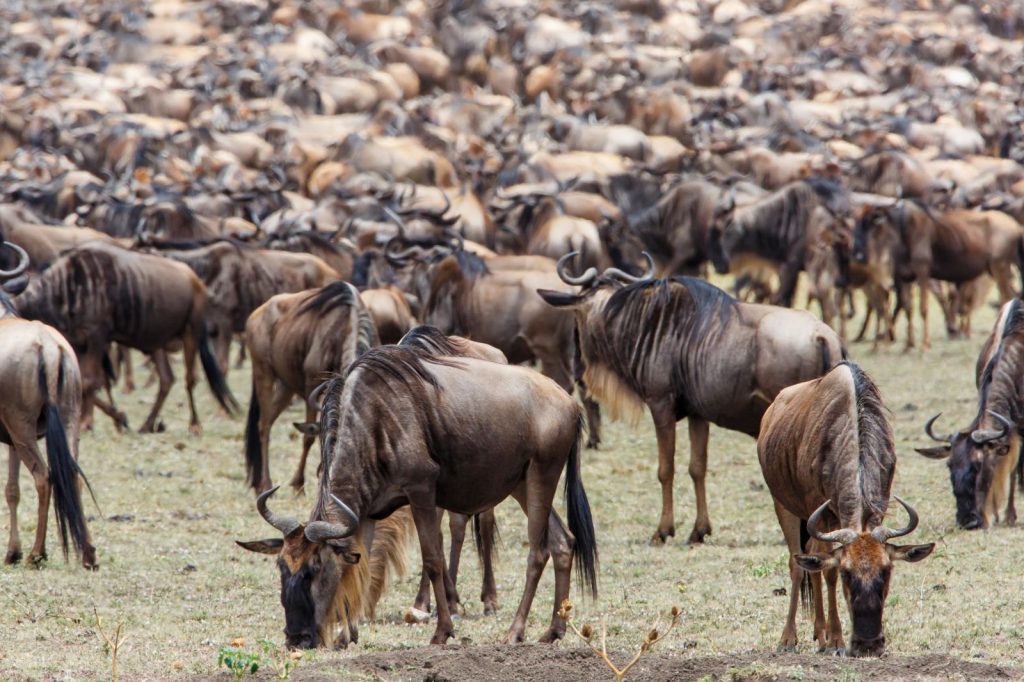Serengeti National Park is the beating heart of Africa’s safari experience and one of the world’s most celebrated wildlife reserves. Located in northern Tanzania and bordering Kenya’s Maasai Mara, the Serengeti spans over 14,750 square kilometres (5,700 square miles) of pristine savannah, woodlands, and riverine forests. It is most famous for hosting the awe-inspiring Great Wildebeest Migration, but beyond that spectacle lies a park of staggering ecological importance, diversity, and beauty.
Established in 1951 and now a UNESCO World Heritage Site, Serengeti is home to more than 70 large mammal species and over 500 bird species, making it a paradise for wildlife lovers, photographers, birders, and anyone seeking a deep connection with untamed nature. The name “Serengeti” comes from the Maasai word Siringet, meaning “the place where the land runs on forever”—a fitting tribute to its seemingly endless golden plains.
Whether you’re on your first safari or a seasoned explorer, Serengeti delivers an unmatched blend of adventure, tranquillity, and raw wilderness.
Serengeti is most famous for the Great Wildebeest Migration—an annual spectacle where over two million wildebeests, zebras, and gazelles traverse the ecosystem in search of fresh grazing and water. This journey follows a circular pattern through the Serengeti and into the Maasai Mara in Kenya, and back again.
This migration is filled with drama: thousands of wildebeests giving birth on the southern plains between January and March, river crossings at the Grumeti and Mara Rivers (with crocodiles lying in wait), and predators like lions and cheetahs following the herds.

The Serengeti offers more than just the migration. The park is home to the Big Five—lions, leopards, elephants, buffaloes, and the elusive black rhino. You’ll also find:
The Serengeti is truly a living canvas of biodiversity.

Each region of the Serengeti offers unique experiences:
Central Serengeti (Seronera): Best year-round game viewing with big cats, river valleys, and access to luxury and mid-range lodges.
Western Corridor: Home to the Grumeti River, where wildebeest cross during the migration between May and July.
Northern Serengeti: Remote and peaceful, with iconic Mara River crossings between July and October.
Southern Serengeti: Ideal from December to March, when the migration herds gather to calve—prime time for predator action.
Serengeti is a year-round safari destination, but timing your visit can enhance your experience:
June – October: Dry season, best for wildlife visibility and predator sightings
July – October: See the Mara River crossings in Northern Serengeti
December – March: Calving season in the Southern Serengeti, when thousands of baby wildebeests are born
April – May: Fewer crowds, lush landscapes, and great birdwatching
Bearfoot Expeditions offers curated experiences to help you see the Serengeti your way:
Guided Game Drives: With experienced local guides who know where the action is
Hot Air Balloon Safaris: Soar above the plains at sunrise and see wildlife from a whole new perspective
Walking Safaris (in designated areas): Discover the smaller details of the ecosystem with expert rangers
Photography Safaris: Led by professional guides for amateur and serious photographers
Cultural Experiences: Add visits to Maasai villages to connect with local traditions
At Bearfoot Expeditions, we specialize in crafting personalized Serengeti adventures—from luxury lodges to classic tented camps. Whether you’re seeking romance, family bonding, solo exploration, or the thrill of the migration, our team will create an itinerary that matches your dreams.
We believe a safari should feel wild, intimate, and soul-stirring—and Serengeti delivers just that.
Let’s design a journey into the wild that you’ll remember forever.
Sign up to receive updates about Women for Forum for African Women Educationalists,
campaigns, and ways to get involved. It’s free to join.
You can unsubscribe at any time, please read our privacy policy for more information
